The Study of Soil Temperature Distribution for Very Low-Temperature Geothermal Energy Applications in Selected Locations of Temperate and Subtropical Climate
Abstract
:1. Introduction
2. Materials and Methods
3. Results and Discussion
3.1. Analysis of Soil Samples
3.2. Soil Temperature Measurements
3.3. A Simplified Model of the Temperature Distribution in the Ground
4. Conclusions
Author Contributions
Funding
Institutional Review Board Statement
Informed Consent Statement
Data Availability Statement
Conflicts of Interest
References
- Sliwa, T.; Sojczyńska, A.; Rosen, A.M.; Kowalski, T. Evaluation of Temperature Profiling Quality in Determining Energy Efficiencies of Borehole Heat Exchangers. Geothermics 2019, 78, 129–137. [Google Scholar] [CrossRef]
- Sakata, Y.; Katsura, T.; Serageldin, A.A.; Nagano, K.; Ooe, M. Evaluating Variability of Ground Thermal Conductivity within a Steep Site by History Matching Underground Distributed Temperatures from Thermal Response Tests. Energies 2021, 14, 1872. [Google Scholar] [CrossRef]
- Sliwa, T.; Sapińska-Śliwa, A.; Gonet, A.; Kowalski, T.; Sojczyńska, A. Geothermal Boreholes in Poland—Overview of the Current State of Knowledge. Energies 2021, 14, 3251. [Google Scholar] [CrossRef]
- Katsura, T.; Sakata, Y.; Ding, L.; Nagano, K. Development of Simulation Tool for Ground Source Heat Pump Systems Influenced by Ground Surface. Energies 2020, 13, 4491. [Google Scholar] [CrossRef]
- Mitchell, M.S.; Spitler, J.D. An Enhanced Vertical Ground Heat Exchanger Model for Whole-Building Energy Simulation. Energies 2020, 13, 4058. [Google Scholar] [CrossRef]
- Gao, S.; Tang, C.; Luo, W.; Han, J.; Teng, B. A New Analytical Model for Calculating Transient Temperature Response of Vertical Ground Heat Exchangers with a Single U-Shaped Tube. Energies 2020, 13, 2120. [Google Scholar] [CrossRef]
- Shimada, Y.; Uchida, Y.; Takashima, I.; Chotpantarat, S.; Widiatmojo, A.; Chokchai, S.; Charusiri, P.; Kurishima, H.; Tokimatsu, K. A Study on the Operational Condition of a Ground Source Heat Pump in Bangkok Based on a Field Experiment and Simulation. Energies 2020, 13, 274. [Google Scholar] [CrossRef] [Green Version]
- Leski, K.; Luty, P.; Gwadera, M.; Larwa, B. Numerical Analysis of Minimum Ground Temperature for Heat Extraction in Horizontal Ground Heat Exchangers. Energies 2021, 14, 5487. [Google Scholar] [CrossRef]
- Gwadera, M.; Kupiec, K. Modeling the Temperature Field in the Ground with an Installed Slinky-Coil Heat Exchanger. Energies 2021, 14, 4010. [Google Scholar] [CrossRef]
- Zhou, Y.; Bidarmaghz, A.; Makasis, N.; Narsilio, G. Ground-Source Heat Pump Systems: The Effects of Variable Trench Separations and Pipe Configurations in Horizontal Ground Heat Exchangers. Energies 2021, 14, 3919. [Google Scholar] [CrossRef]
- Kim, K.; Kim, J.; Nam, Y.; Lee, E.; Kang, E.; Entchev, E. Analysis of Heat Exchange Rate for Low-Depth Modular Ground Heat Exchanger through Real-Scale Experiment. Energies 2021, 14, 1893. [Google Scholar] [CrossRef]
- Sorokins, J.; Borodinecs, A.; Zemitis, J. Application of ground-to-air heat exchanger for preheating of supply air. IOP Conf. Ser. Earth Environ. Sci. 2017, 90, 012002. [Google Scholar] [CrossRef] [Green Version]
- EN 15698-1:2020-01; District Heating Pipes—Bonded Twin Pipe Systems for Directly Buried Hot Water Networks—Part 1: Factory Made Twin Pipe Assembly of Steel Service Pipes, Polyurethane Thermal Insulation and One Casing of Polyethylene. European Committee for Standardization: Brussels, Belgium, 2019.
- EN 13941-1:2019; District Heating Pipes—Design and Installation of Thermal Insulated Bonded Single and Twin Pipe Systems for Directly Buried Hot Water Networks—Part 1: Design. European Committee for Standardization: Brussels, Belgium, 2019.
- Bøhm, B.; Kristjansson, H. Single, twin and triple buried heating pipes: On potential savings in heat losses and costs. Int. J. Energy Res. 2005, 29, 1301–1312. [Google Scholar] [CrossRef]
- Van der Heijde, B.; Aertgeerts, A.; Helsen, L. Modelling steady-state thermal behavior of double thermal network pipes. Int. J. Therm. Sci. 2017, 117, 316–327. [Google Scholar] [CrossRef] [Green Version]
- Krawczyk, D.A.; Teleszewski, T.J. Optimization of Geometric Parameters of Thermal Insulation of Pre-Insulated Double Pipes. Energies 2019, 12, 1012. [Google Scholar] [CrossRef] [Green Version]
- Danielewicz, J.; Śniechowska, B.; Sayegh, M.A.; Fidorów, N.; Jouhara, H. Three-dimensional numerical model of heat losses from district heating network pre-insulated pipes buried in the ground. Energy 2016, 108, 172–184. [Google Scholar] [CrossRef] [Green Version]
- Danielewicz, J.; Fidorow, N.; Jadwiszczak, P.; Szulgowska-Zgrzywa, M. The exploitation costs for various heating systems according to the energetic certification law in Poland. Energy Sources Part B Econ. Plan. Policy 2014, 9, 301–306. [Google Scholar] [CrossRef]
- Information Materials of Logstor Companies. 2012. (01/02). Available online: http://www.logstor.com/ (accessed on 1 March 2022).
- Terradas-III, G.; Triolo, J.M.; Pham, C.H.; Martí-Herrero, J.; Sommer, S.G. Thermic model to predict biogas production in unheated fixed dome digesters buried in the ground. Environ. Sci. Technol. 2014, 48, 3253–3262. [Google Scholar] [CrossRef]
- Rainier, H.; Nouceiba, A.; Yves, J.; Marie-Noëlle, P. Modeling and simulation of heat transfer phenomena in a semi-buried anaerobic digester. Chem. Eng. Res. Des. 2017, 119, 101–116. [Google Scholar]
- Teleszewski, T.J.; Żukowski, M. Analysis of Heat Loss of a Biogas Anaerobic Digester in Weather Conditions in Poland. J. Ecol. Eng. 2018, 19, 242–250. [Google Scholar] [CrossRef]
- Larwa, B. Heat Transfer Model to Predict Temperature Distribution in the Ground. Energies 2019, 12, 25. [Google Scholar] [CrossRef] [Green Version]
- Kupiec, K.; Larwa, B.; Gwadera, M. Heat transfer in horizontal ground heat exchangers. Appl. Therm. Eng. 2015, 75, 270–276. [Google Scholar] [CrossRef]
- Ouzzane, M.; Eslami-Nejad, P.; Aidoun, Z.; Lamarche, L. Analysis of the convective heat exchange effect on the undisturbed ground temperature. Sol. Energy 2014, 108, 340–347. [Google Scholar] [CrossRef]
- Gwadera, M.; Larwa, B.; Kupiec, K. Undisturbed ground temperature—Different methods of determination. Sustainability 2017, 9, 2055. [Google Scholar] [CrossRef] [Green Version]
- Carslaw, H.S.; Jaeger, J.C. Conduction of Heat in Solids, 2nd ed.; Clarendon Press: Oxford, UK, 1959; ISBN 978-0198533030. [Google Scholar]
- Rao, K.G. Estimation of the exchange coefficient of heat during low wind convective conditions. Bound. Layer Meteorol. 2004, 111, 247–273. [Google Scholar] [CrossRef]
- McAdams, W.H. Heat Transmission; McGraw-Hill: New York, NY, USA, 1954. [Google Scholar]
- Molina-Rodea, R.; Wong-Loya, J.A. A new model to predict subsoil-thermal profiles based on seasonal rain conditions and soil properties. Geothermics 2021, 97, 102261. [Google Scholar] [CrossRef]
- Le, A.T.; Wang, L.; Wang, Y.; Li, D. Measurement investigation on the feasibility of shallow geothermal energy for heating and cooling applied in agricultural greenhouses of Shouguang City: Ground temperature profiles and geothermal potential. Inf. Processing Agric. 2021, 8, 251–269. [Google Scholar] [CrossRef]
- Al-Hinti, I.; Al-Muhtady, A.; Al-Kouz, W. Measurement and modelling of the ground temperature profile in Zarqa, Jordan for geothermal heat pump applications. Appl. Therm. Eng. 2017, 123, 131–137. [Google Scholar] [CrossRef]
- Tong, C.; Li, X.; Duanmu, L.; Wang, H. Prediction of the temperature profiles for shallow ground in cold region and cold winter hot summer region of China. Energy Build. 2021, 242, 110946. [Google Scholar] [CrossRef]
- Available online: https://datasheets.maximintegrated.com/en/ds/DS18B20.pdf (accessed on 23 April 2022).
- PN-EN ISO 14688-1:2018-05; Geotechnical Investigation and Testing—Identification and Classification of Soil—Part 1: Identification and Description (ISO 14688-1:2017). European Committee for Standardization: Brussels, Belgium, 2017.
- Rose, C.W. Agricultural Physics; Pergamon: Oxford, UK, 1966; p. 230. [Google Scholar]
- PN-EN ISO 6946: 1999; Building Components and Building Elements—Thermal Resistance and Thermal Transmittance—Calculation Method. European Committee for Standardization: Brussels, Belgium, 1996.
- Whittig, L.D.; Allardice, W.R. X-ray diffraction techniques. In Methods of Soil Analysis. Part 1. Physical and Mineralogical Methods, 2nd ed.; Klute, A., Ed.; Agron. Monogr. 9; ASA and SSSA: Madison, WI, USA, 1986; pp. 331–362. [Google Scholar]
- JCPD. Joint Committee on Powder Diffraction Standards; International Center for Diffraction Data: Swarthmore, PA, USA, 1995. [Google Scholar]
- Andújar Márquez, J.M.; Martínez Bohórquez, M.Á.; Gómez Melgar, S. Ground Thermal Diffusivity Calculation by Direct Soil Temperature Measurement. Application to very Low Enthalpy Geothermal Energy Systems. Sensors 2016, 16, 306. [Google Scholar] [CrossRef] [Green Version]
- Available online: https://solargis.com/maps-and-gis-data/overview (accessed on 1 March 2022).
- PN-EN 12524:2003; Building Materials and Products—Hygrothermal Properties—Tabulated Design Values. European Committee for Standardization: Brussels, Belgium, 2000.
- Riche, F.; Schneebeli, M. Thermal conductivity of snow measured by three independent methods and anisotropy considerations. Cryosphere 2013, 7, 217–227. [Google Scholar] [CrossRef] [Green Version]
- Available online: https://www.azom.com/properties.aspx?ArticleID=52 (accessed on 23 April 2022).
- Ottestad, P. Time-series described by trigonometric functions and the possibility of acquiring reliable forecasts for climatic and other biospheric variables. J. Interdiscip. Cycle Res. 1986, 17, 29–49. [Google Scholar] [CrossRef]
- WTA. Simulation of Heat and Moisture Transfer. Guideline 6-2-01/E; WTA-Publications: München, Germany, 2004. [Google Scholar]
- WUFI® 2D Calculation Example Step by Step. Available online: https://wufi.de/en/wp-content/uploads/sites/9/2014/09/WUFI2D-3_Example.pdf (accessed on 23 April 2022).
- Leaf, J.S.; Erell, E. A model of the ground surface temperature for micrometeorological analysis. Theor. Appl. Climatol. 2018, 133, 697–710. [Google Scholar] [CrossRef]
- Kusuda, T.; Achenbach, P.R. Earth temperature and thermal diffusivity at selected stations in the United States. ASHRAE Trans. 1965, 71, 61–75. [Google Scholar]
- Nidal, H. Abu-Hamdeh Ground Thermal Properties of Soils as affected by Density and Water Content. Biosyst. Eng. 2003, 86, 97–102. [Google Scholar] [CrossRef]
- Arkhangelskaya, T.A.; Lukiashchenko, K.I. Estimating soil thermal diffusivity at different water contents from easily available data on soil texture, bulk density, and organic carbon content. Biosyst. Eng. 2018, 168, 83–95. [Google Scholar] [CrossRef]



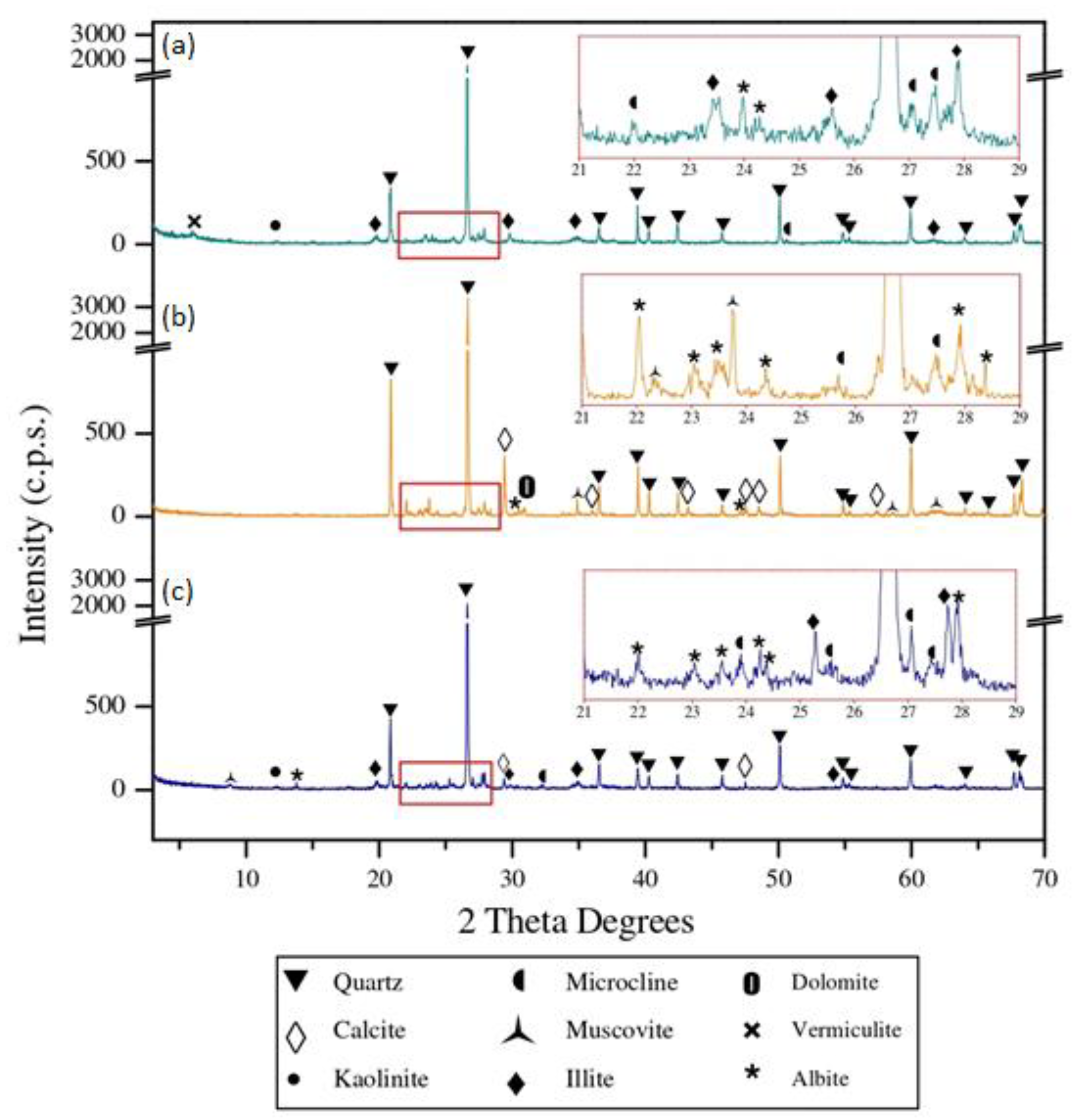
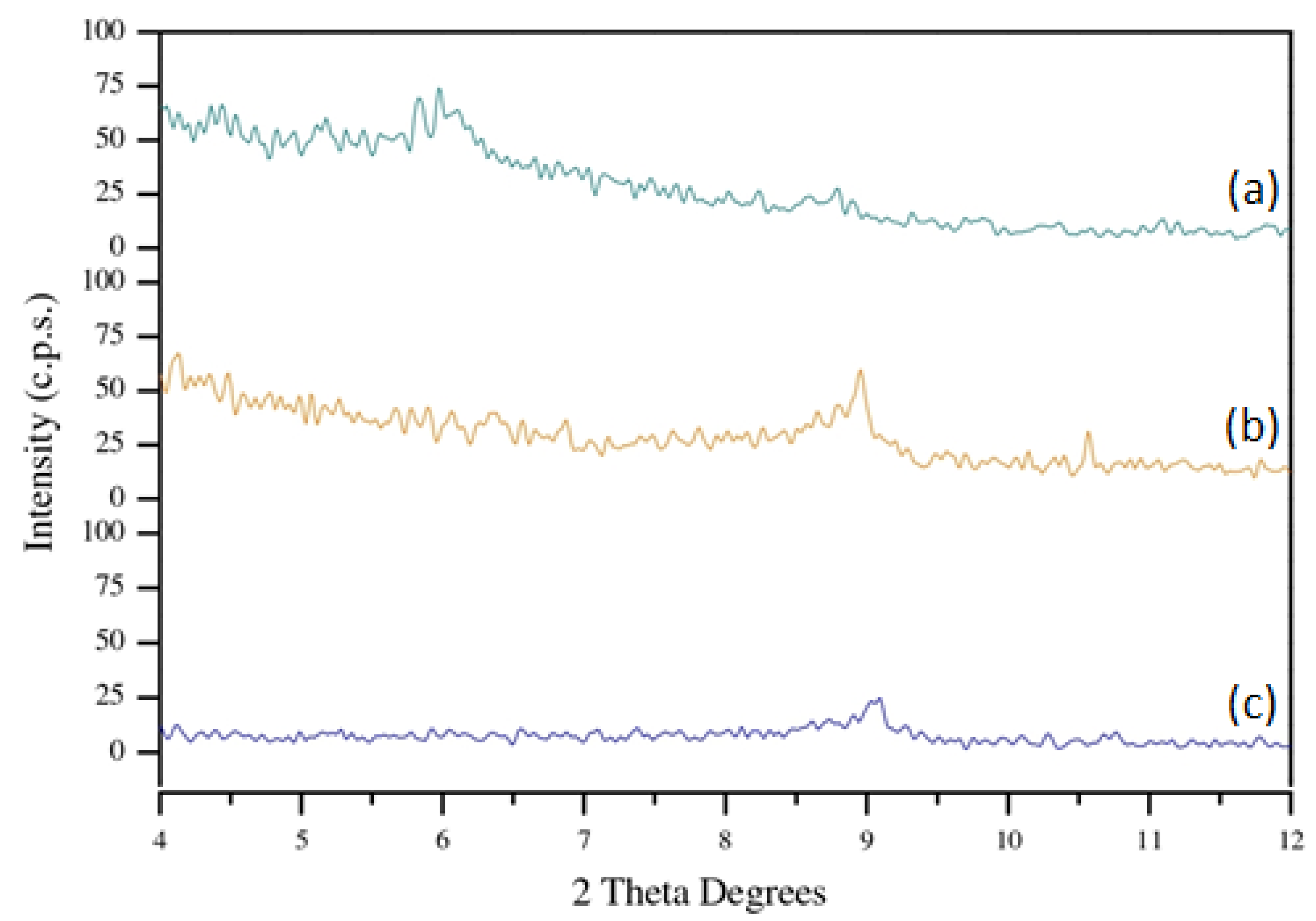
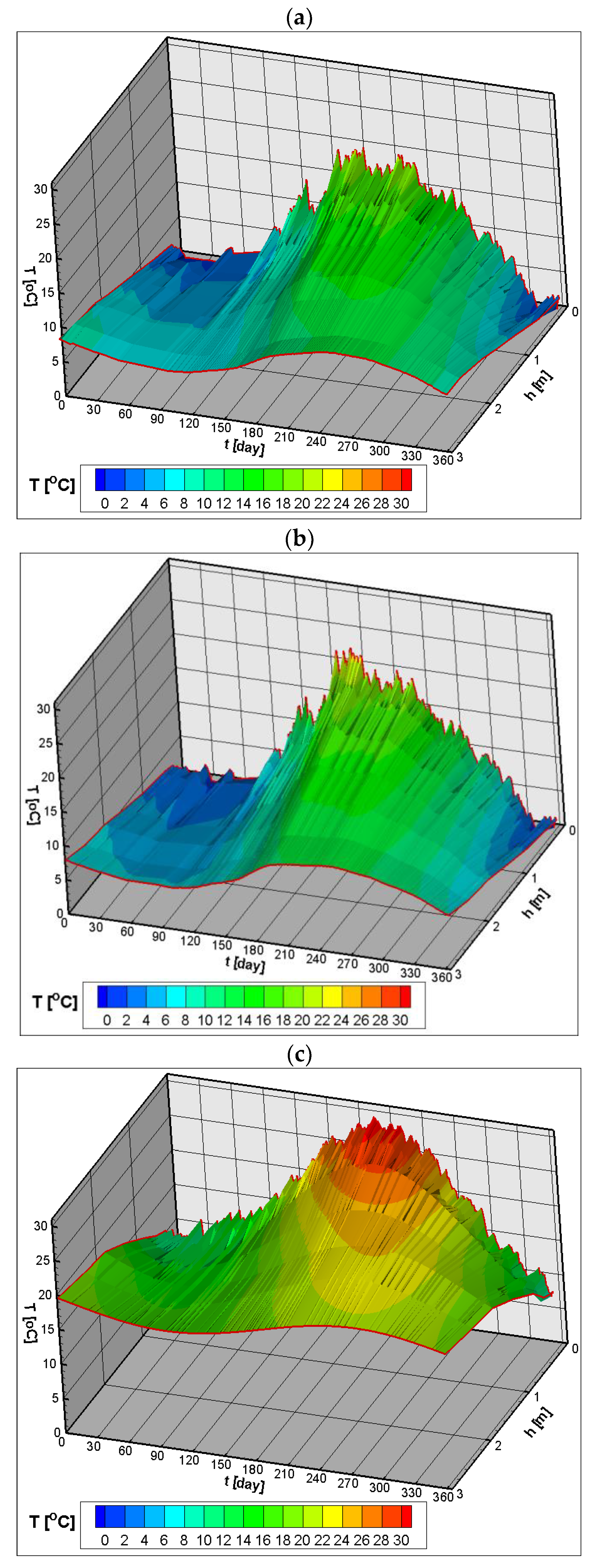
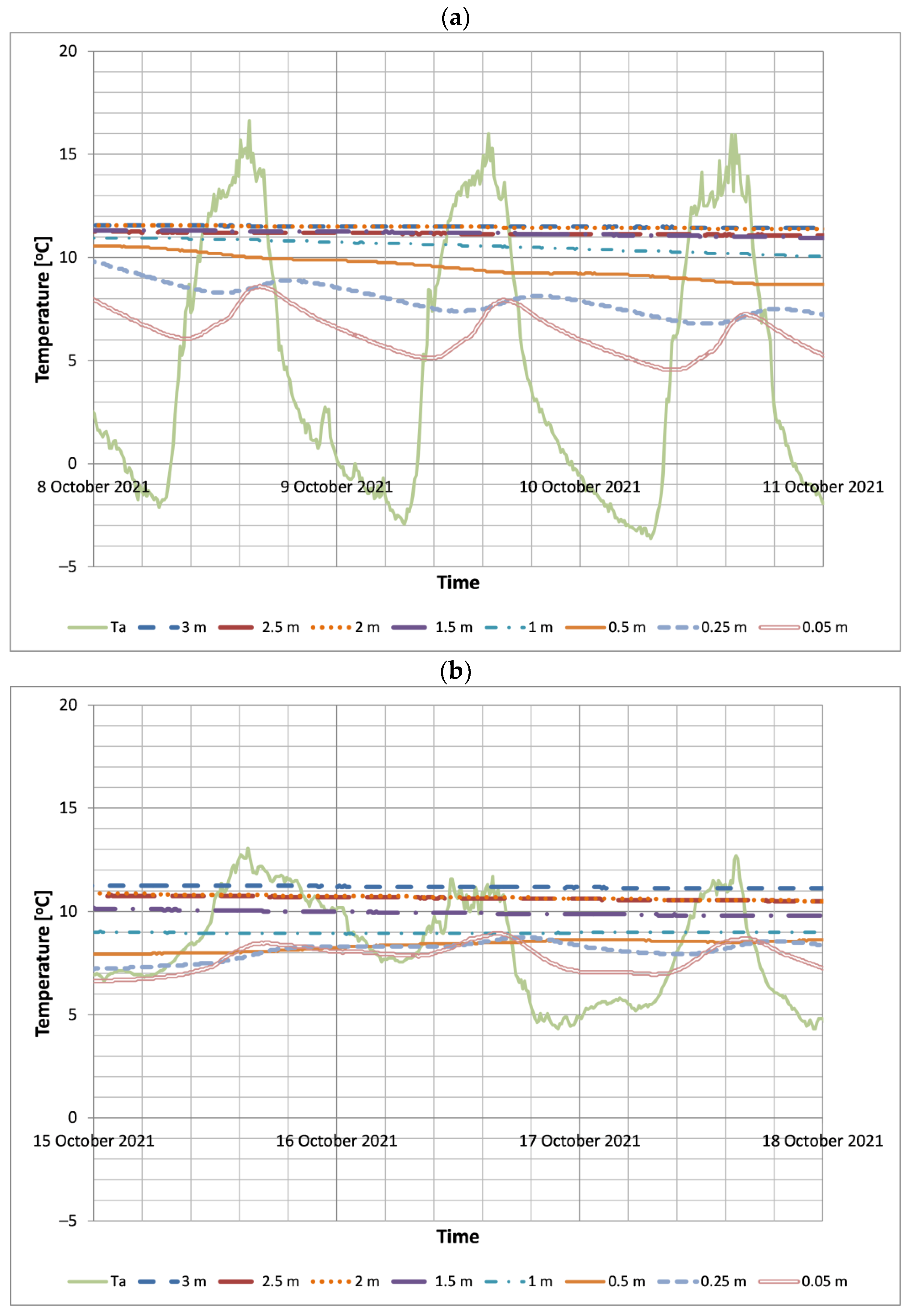
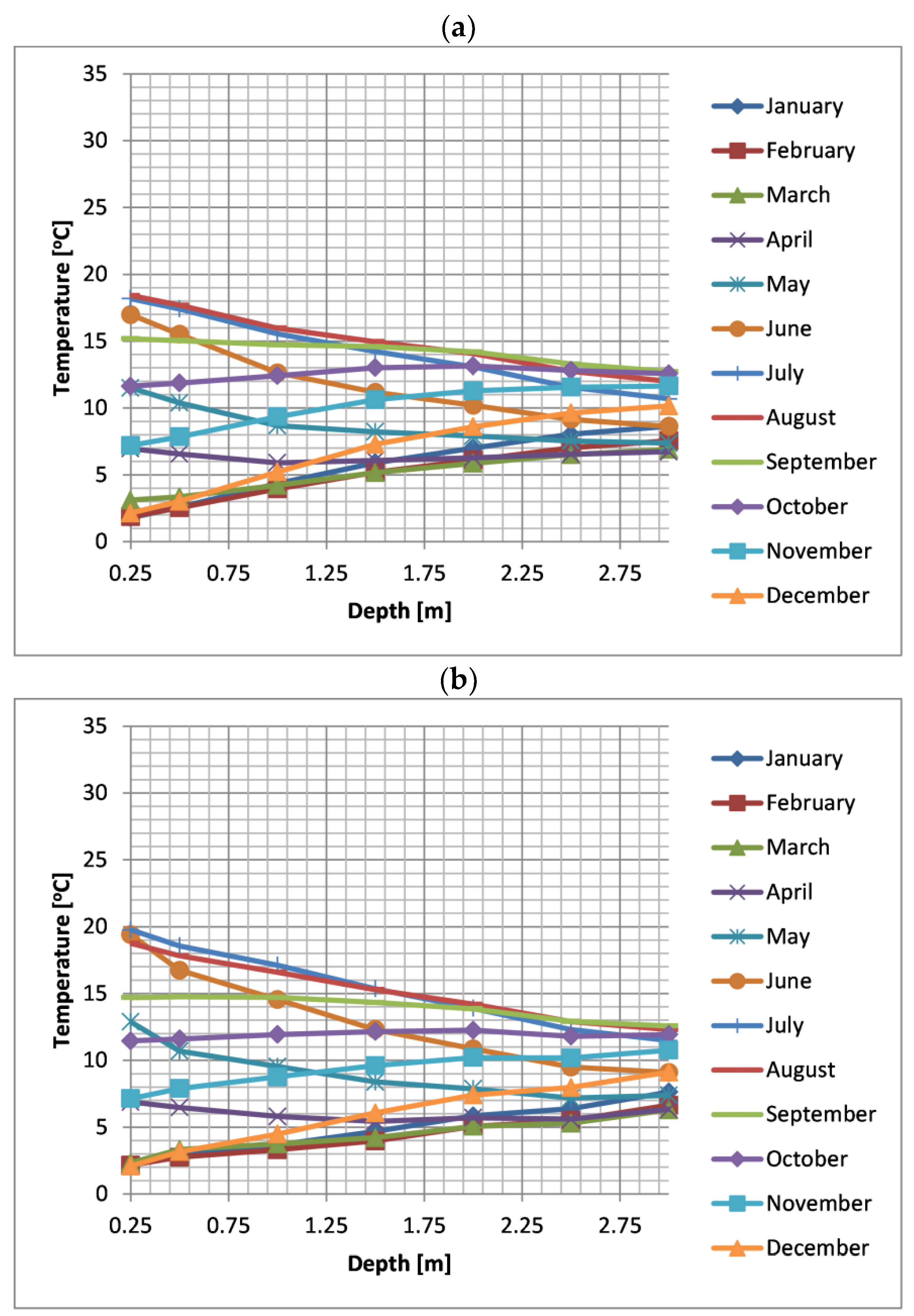
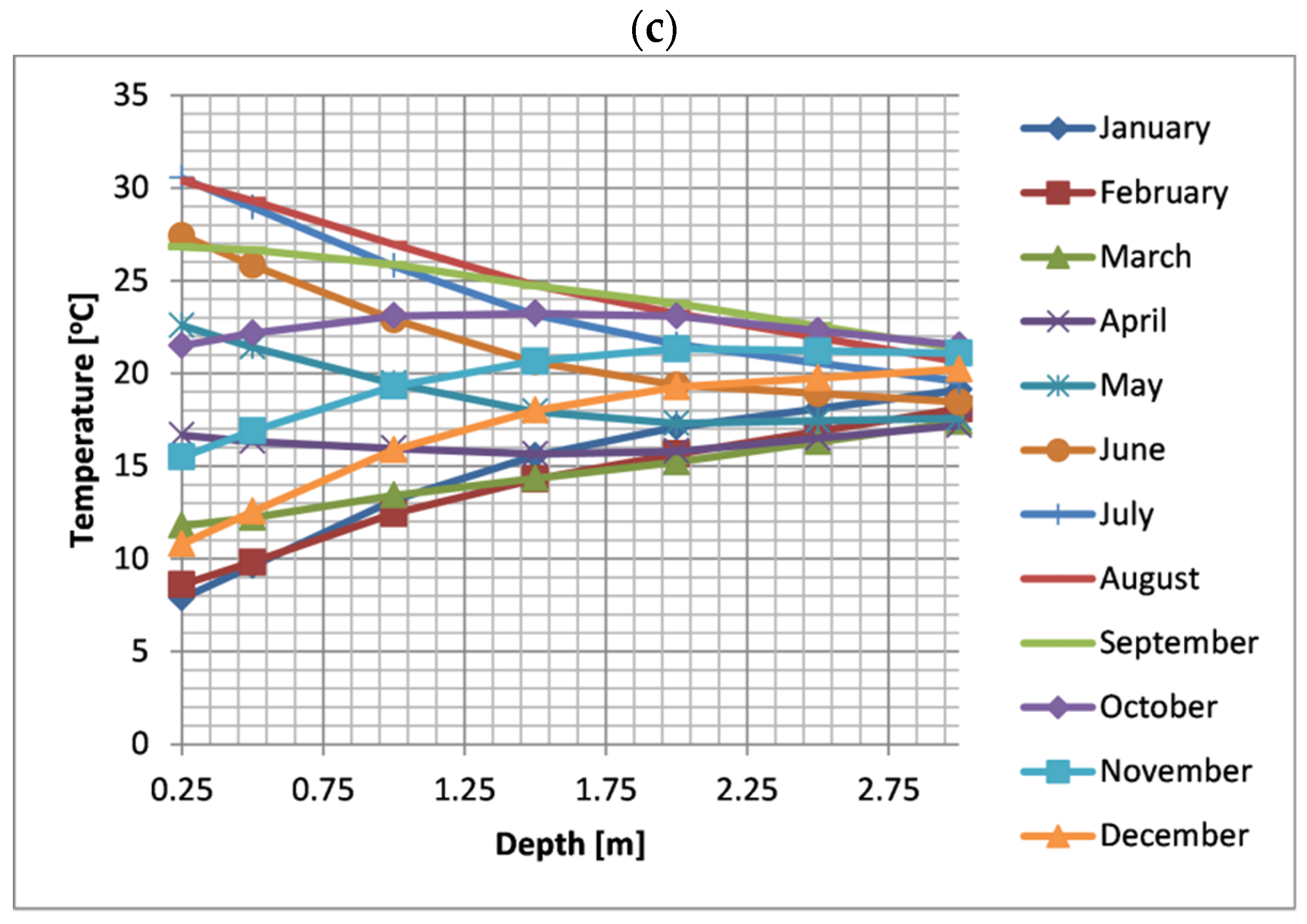
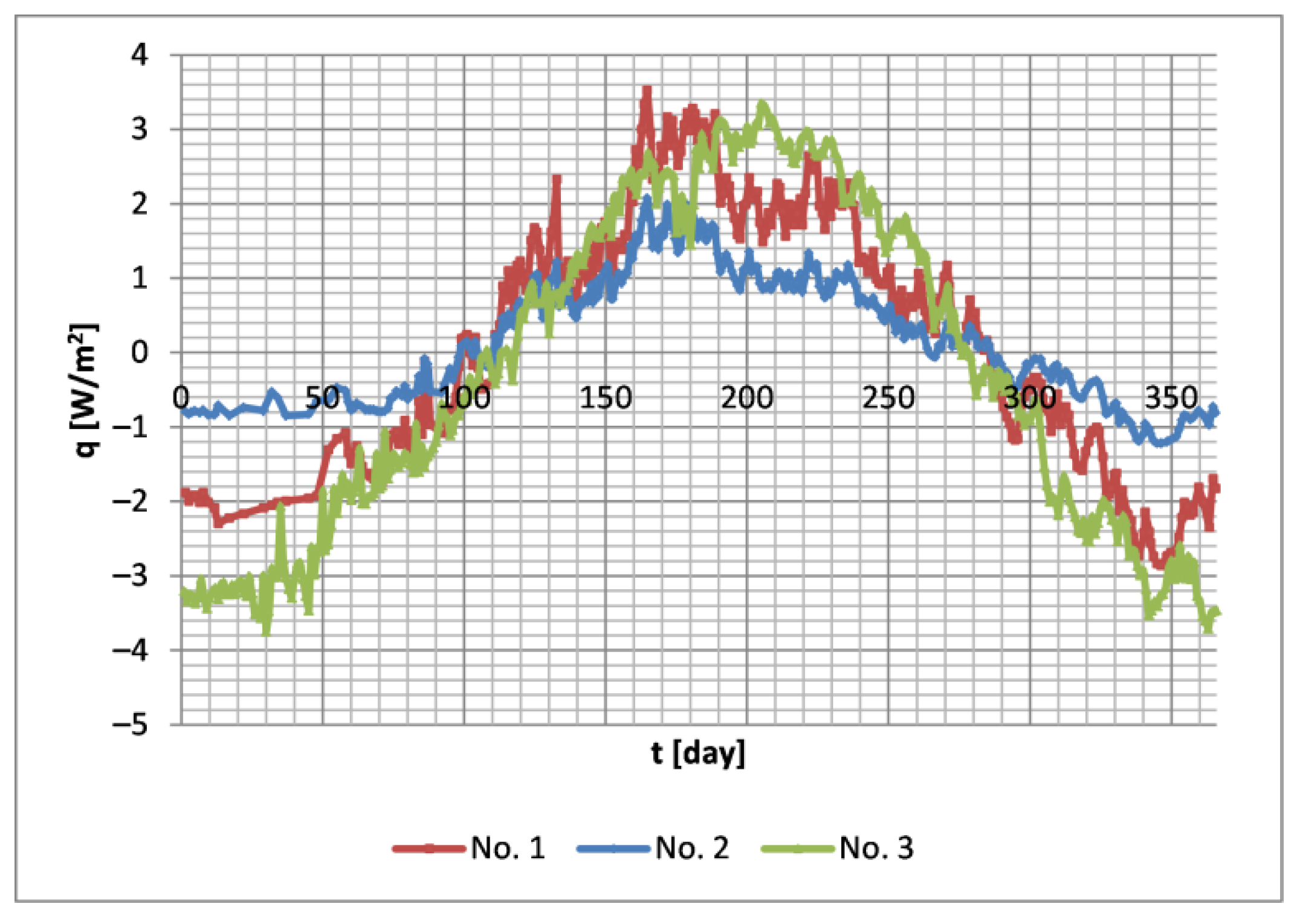
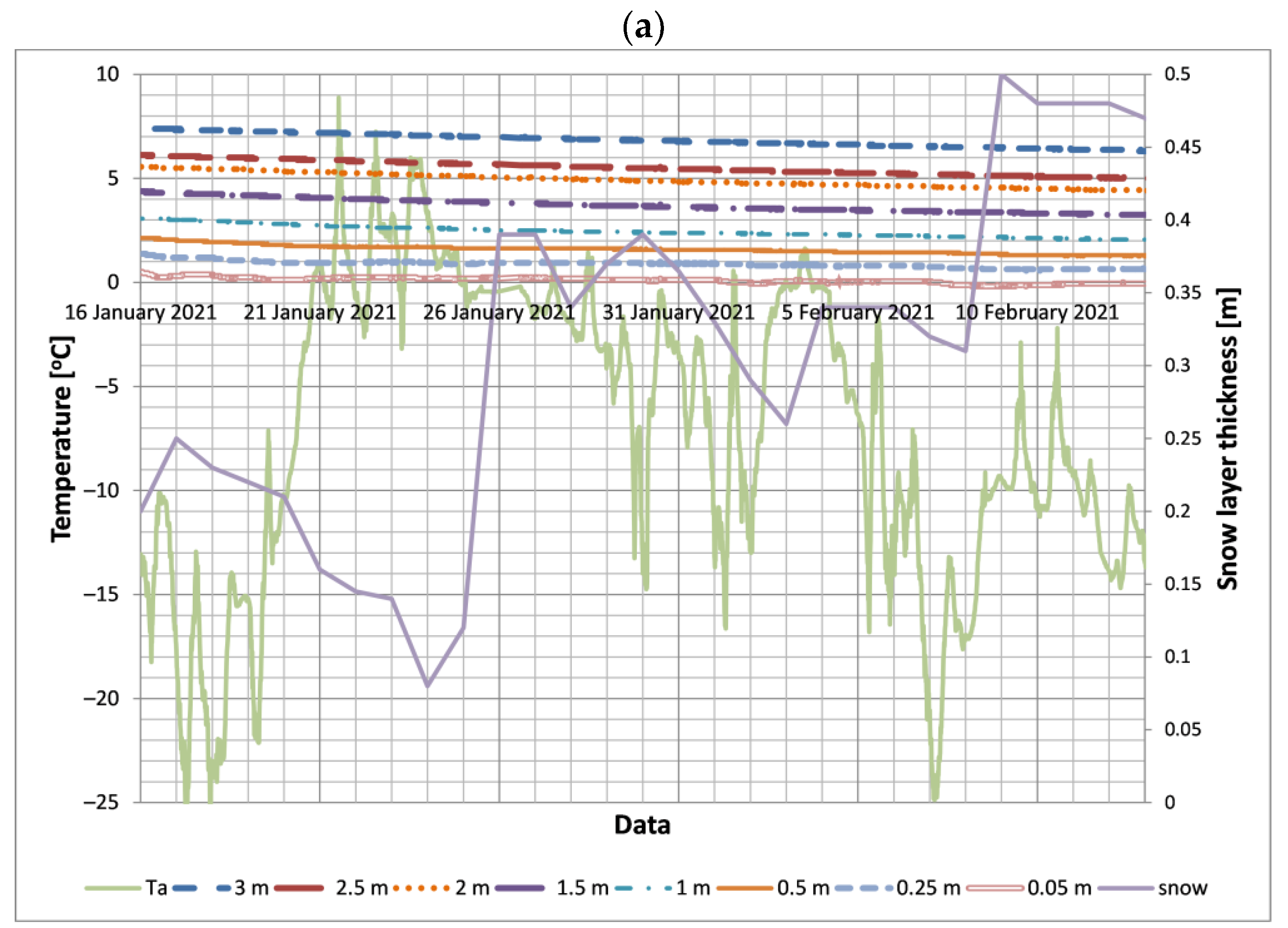
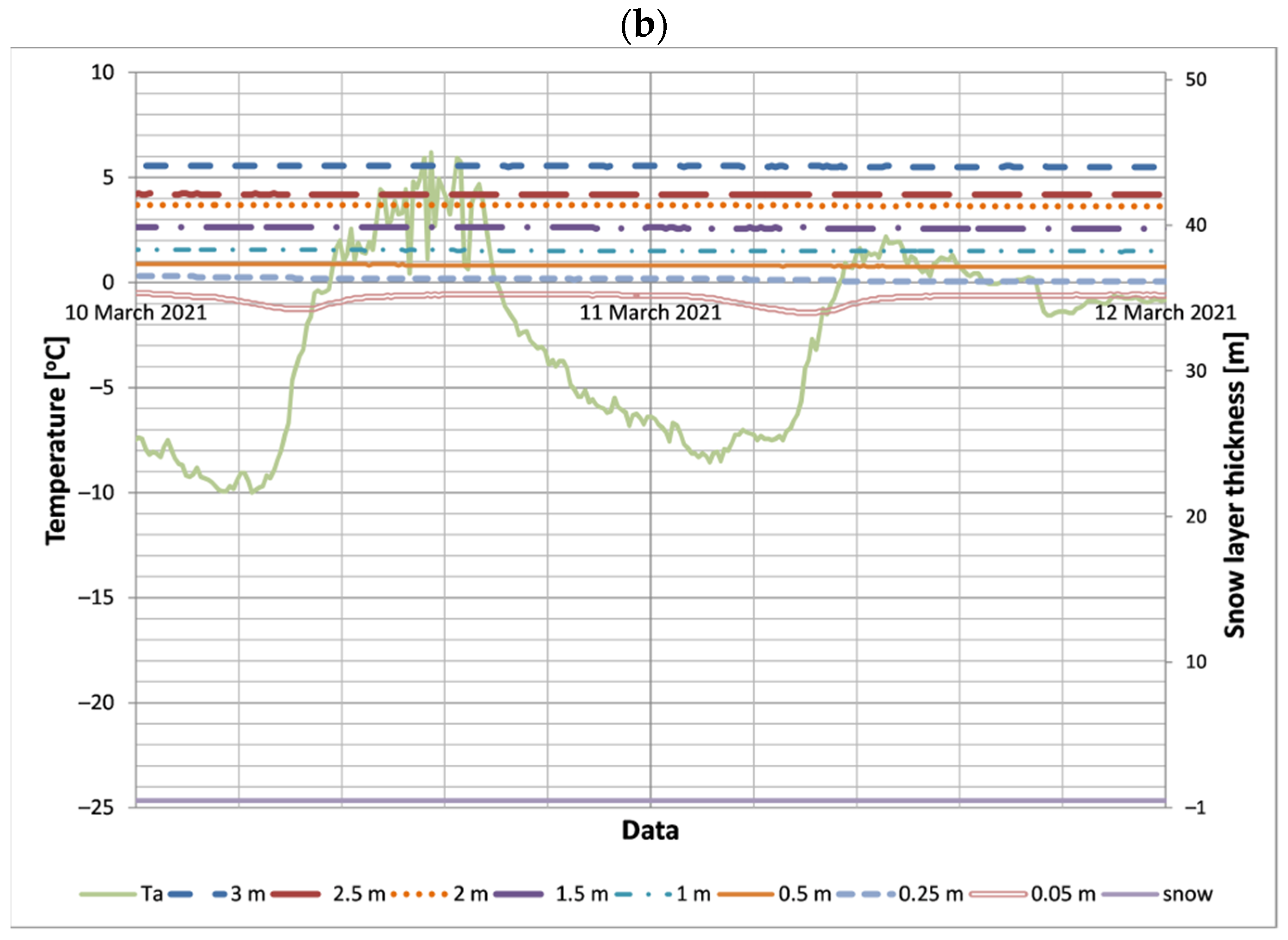


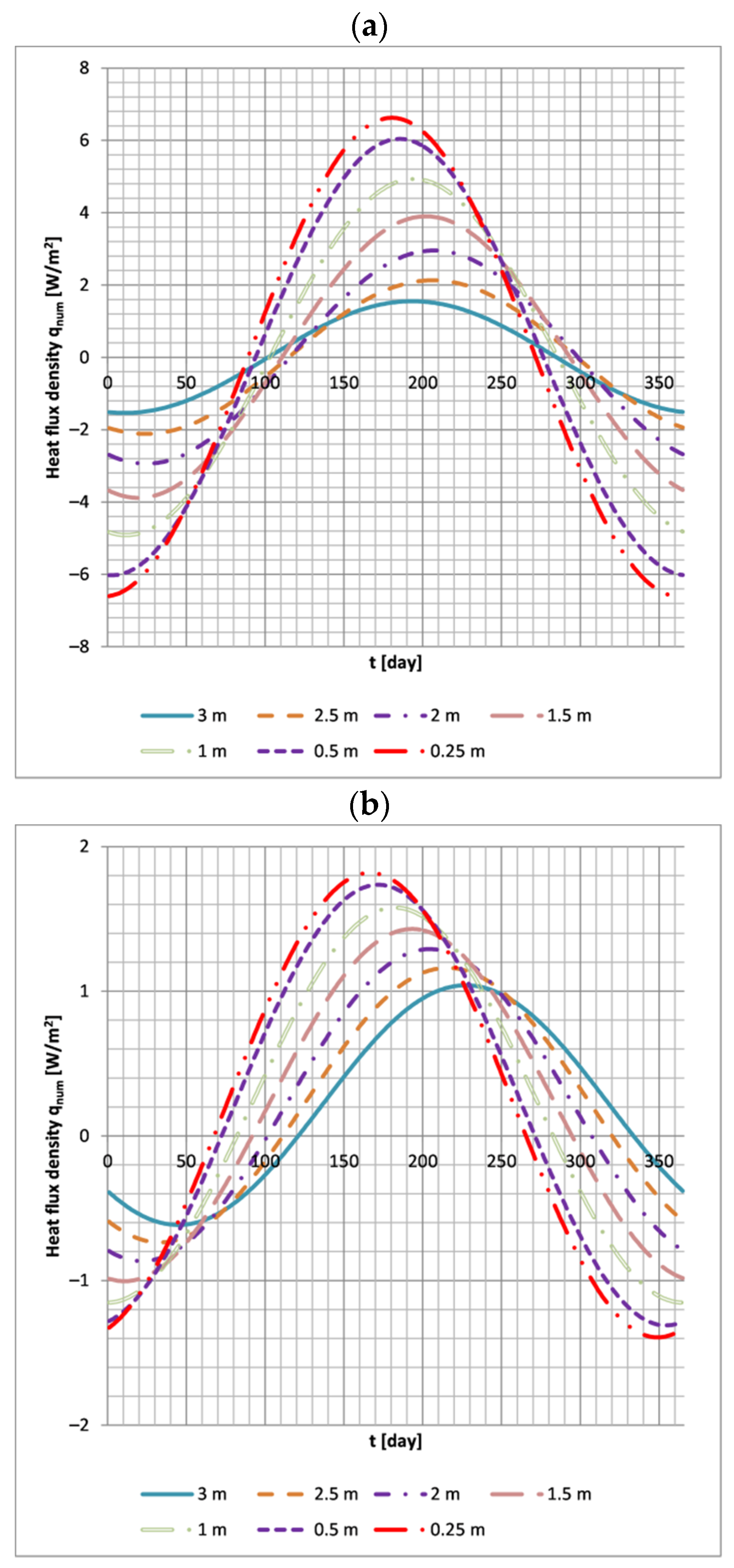
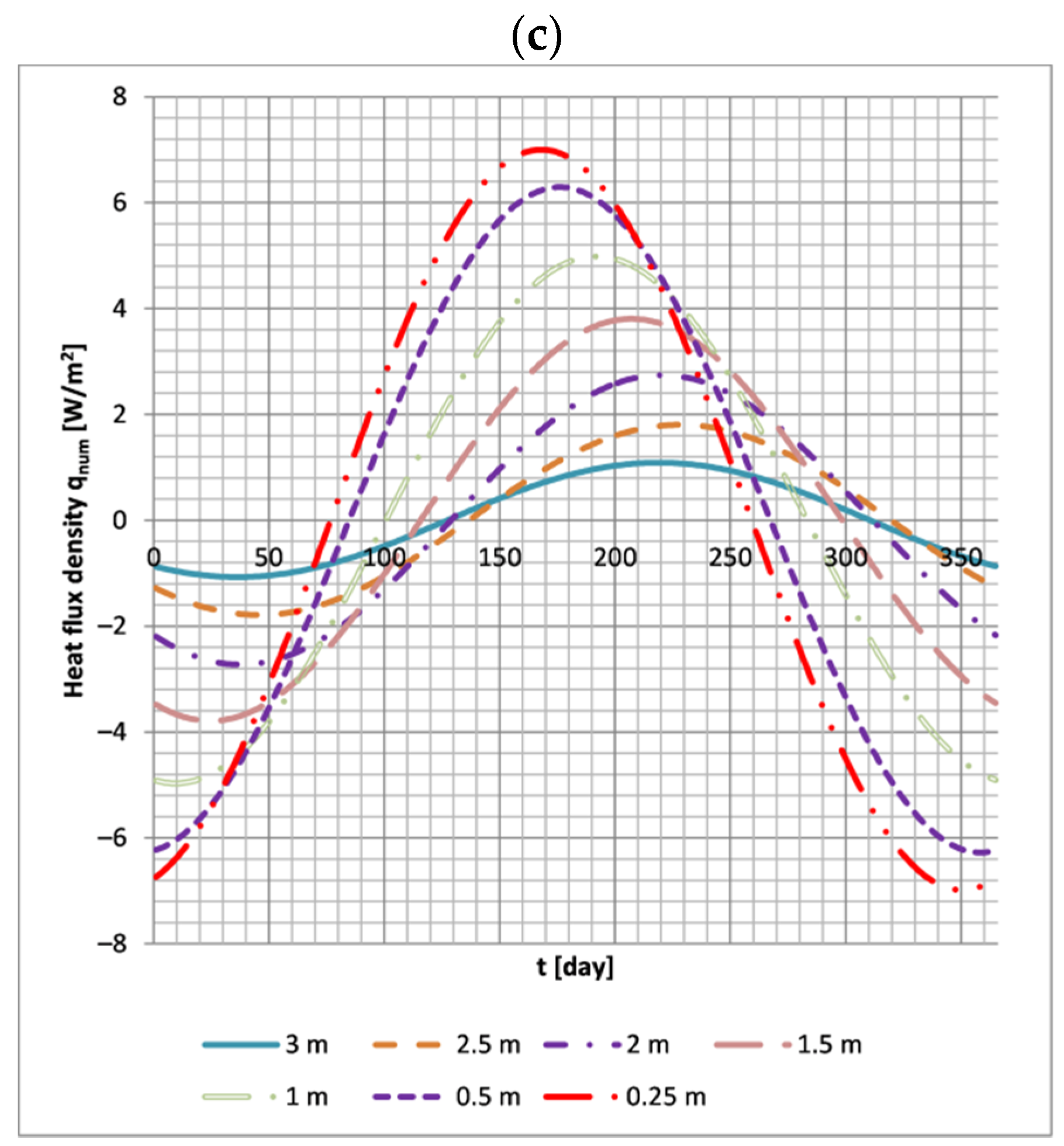
| Measurement Point ID | Location | Climate Type | Geographic Coordinates | Type of Soil | Groundwater Level |
|---|---|---|---|---|---|
| 1 | Bialystok (Poland) | Temperate | 53°05′19.8″ N 23°13′49.1″ E | Clay | 20 m |
| 2 | Bialystok (Poland) | Temperate | 53°05′21.4″ N 23°13′50.3″ E | Sand | 20 m |
| 3 | Belmez (Spain) | Subtropical | 38°15′57.8″ N 5°12′32.4″ W | Clay | 100 m |
| Compound | Measurement Point 1 | Measurement Point 2 | Measurement Point 3 |
|---|---|---|---|
| Na2O | 0.61 | 0.85 | 0.68 |
| MgO | 1.87 | 0.81 | 0.85 |
| Al2O3 | 12.57 | 4.84 | 12.11 |
| SiO2 | 50.28 | 51.11 | 48.36 |
| P2O5 | 0.19 | 0.21 | 0.23 |
| SO3 | 0.05 | - | 0.19 |
| Cl | - | 0.01 | 0.01 |
| K2O | 3.30 | 2.03 | 2.24 |
| CaO | 1.12 | 9.96 | 2.65 |
| TiO2 | 0.51 | 0.11 | 0.71 |
| Cr2O3 | 0.02 | 0.13 | 0.09 |
| MnO | 0.06 | 0.04 | 0.10 |
| Fe2O3 | 4.69 | 1.16 | 3.63 |
| NiO | - | 0.01 | - |
| Rb2O | 0.01 | - | - |
| SrO | - | 0.02 | - |
| ZrO2 | 0.04 | - | 0.04 |
| BaO | 0.03 | 0.15 | 0.09 |
| CO2 balance | 24.65 | 28.57 | 28.01 |
| Total mass | 100.00 | 100.00 | 100.00 |
| Point Number | a2 | a1 | a0 | b1 | b0 | c1 | c0 |
|---|---|---|---|---|---|---|---|
| 1 | 0.672 | −4.548 | 11.357 | 17.394 | −151.28 | −0.4156 | 10.418 |
| 2 | 0.190 | −2.943 | 10.711 | 16.453 | −157.12 | −0.5324 | 10.093 |
| 3 | 1.023 | −6.714 | 13.406 | 26.618 | −162 | −0.009 | 19.446 |
| Physical meaning | - |
| Point Number | α(A) 10−6 m2/s | α(B) 10−6 m2/s | Tm °C | A0 °C | t0 day |
|---|---|---|---|---|---|
| 1 | 0.73 | 1.10 | 10.418 | 11.357 | −151.28 |
| 2 | 1.27 | 1.24 | 10.093 | 10.711 | −157.12 |
| 3 | 0.52 | 0.47 | 19.446 | 13.406 | −162 |
Publisher’s Note: MDPI stays neutral with regard to jurisdictional claims in published maps and institutional affiliations. |
© 2022 by the authors. Licensee MDPI, Basel, Switzerland. This article is an open access article distributed under the terms and conditions of the Creative Commons Attribution (CC BY) license (https://creativecommons.org/licenses/by/4.0/).
Share and Cite
Teleszewski, T.J.; Krawczyk, D.A.; Fernandez-Rodriguez, J.M.; Lozano-Lunar, A.; Rodero, A. The Study of Soil Temperature Distribution for Very Low-Temperature Geothermal Energy Applications in Selected Locations of Temperate and Subtropical Climate. Energies 2022, 15, 3345. https://doi.org/10.3390/en15093345
Teleszewski TJ, Krawczyk DA, Fernandez-Rodriguez JM, Lozano-Lunar A, Rodero A. The Study of Soil Temperature Distribution for Very Low-Temperature Geothermal Energy Applications in Selected Locations of Temperate and Subtropical Climate. Energies. 2022; 15(9):3345. https://doi.org/10.3390/en15093345
Chicago/Turabian StyleTeleszewski, Tomasz Janusz, Dorota Anna Krawczyk, Jose María Fernandez-Rodriguez, Angélica Lozano-Lunar, and Antonio Rodero. 2022. "The Study of Soil Temperature Distribution for Very Low-Temperature Geothermal Energy Applications in Selected Locations of Temperate and Subtropical Climate" Energies 15, no. 9: 3345. https://doi.org/10.3390/en15093345
APA StyleTeleszewski, T. J., Krawczyk, D. A., Fernandez-Rodriguez, J. M., Lozano-Lunar, A., & Rodero, A. (2022). The Study of Soil Temperature Distribution for Very Low-Temperature Geothermal Energy Applications in Selected Locations of Temperate and Subtropical Climate. Energies, 15(9), 3345. https://doi.org/10.3390/en15093345









